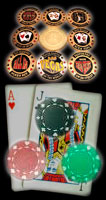D.R.Sherer, No Fold Holdem, Poker Plus
Publication, 1997
This is something of a unique poker books. It ’s not a book for beginners.
Its perspective is that money flows from bad players to good players, and its focus is on how to exploit the errors of the typical weak-tight player.
The main problem with the book is that Sherer doesn’t explicitly tell you his focus.
If you take the book at face value, it might seem like a book that suggests that hands such as 7 ![]() 5
5 ![]() are strong hands that should be played aggressively.
are strong hands that should be played aggressively.
The book is about how to play hands like that aggressively, but the context of the play is when you are able to get heads-up against a tight player who at times tends to give up too easily and at other times falls in love with his hand.
The book also has some discussion on poker hand value in very loose and very passive games that’s valuable, but the real benefit is learning when you don’t need to have the best hand in a confrontation between a made hand and draw if the other player has exploitable weaknesses.
However, the book is written by a poker player, not a writer, and it isn’t written well enough for someone without a lot of table experience to profit from it.
David Sklansky and Mason Malmuth, Holdem for Advanced Players,Two Plus Two Publishing, 1999
This book was originally published in 1988. A more recent edition, with some new material, has recently been published.
The book has a strong orientation toward perspectives of domination and deception. It ’s geared mostly toward attacking loose-passive players with a strong focus on plays like semi-bluffs.
It provides good coverage of many profitable deceptive plays that work well against small fields of weak players and covers a lot of material that give you strong clues in reading tougher players that you’re likely to find at tight or typical tables.
If for no other reason than it’s widely read book, this book is a must read for any serious Holdem player. Your tougher opponents have read this book. You need to read it, too.
The new material that’s been added in the second edition is mostly on short-handed play and playing in loose, wild games.
The heads-up material in the short-handed play section is good and well worth reading.
The mater4ial for play in loose, wild poker games suffers from author’s tendency to stress perspectives of domination and deception, two perspectives that don’t really add much value to play in very loose and very aggressive games.



